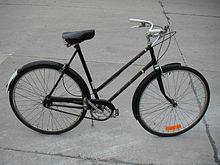History:The great majority of today's bicycles have a frame with upright seating that looks much like the first chain-driven bike.[3][4][5]These upright bicycles almost always feature the diamond frame, a truss consisting of two triangles: the front triangle and the rear triangle. The front triangle consists of the head tube, top tube, down tube, and seat tube. The head tube contains theheadset, the set of bearings that allows the fork to turn smoothly for steering and balance. The top tube connects the head tube to the seat tube at the top, and the down tube connects the head tube to the bottom bracket. The rear triangle consists of the seat tube and paired chain stays and seat stays. The chain stays run parallel to the chain, connecting the bottom bracket to the rear dropout, where the axle for the rear wheel is held. The seat stays connect the top of the seat tube (at or near the same point as the top tube) to the rear fork ends.
Historically, women's bicycle frames had a top tube that connected in the middle of the seat tube instead of the top, resulting in a lower standover height at the expense of compromised structural integrity, since this places a strong bending load in the seat tube, and bicycle frame members are typically weak in bending. This design, referred to as a step-through frame or as an open frame, allows the rider to mount and dismount in a dignified way while wearing a skirt or dress. While some women's bicycles continue to use this frame style, there is also a variation, themixte, which splits the top tube laterally into two thinner top tubes that bypass the seat tube on each side and connect to the rear fork ends. The ease of stepping through is also appreciated by those with limited flexibility or other joint problems. Because of its persistent image as a "women's" bicycle, step-through frames are not common for larger frames.
Step-throughs were popular partly for practical reasons and partly for social mores of the day. For most of the history of bicycles' popularity women have worn long skirts, and the lower frame accommodated these better than the top-tube. Furthermore, it was considered "unladylike" for women to open their legs to mount and dismount - in more conservative times women who rode bicycles at all were vilified as immoral or immodest. These practices were akin to the older practice of riding horse sidesaddle.
Another style is the recumbent bicycle. These are inherently more aerodynamic than upright versions, as the rider may lean back onto a support and operate pedals that are on about the same level as the seat. The world's fastest bicycle is a recumbent bicycle but this type was banned from competition in 1934 by the Union Cycliste Internationale.[34]
Historically, materials used in bicycles have followed a similar pattern as in aircraft, the goal being high strength and low weight. Since the late 1930s alloy steels have been used for frame and fork tubes in higher quality machines. By the 1980s aluminum welding techniques had improved to the point that aluminum tube could safely be used in place of steel. Since then aluminum alloy frames and other components have become popular due to their light weight, and most mid-range bikes are now principally aluminum alloy of some kind.[where?] More expensive bikes use carbon fibre due to its significantly lighter weight and profiling ability, allowing designers to make a bike both stiff and compliant by manipulating the lay-up. Other exotic frame materials include titanium and advanced alloys. Bamboo, a naturalcomposite material with high strength-to-weight ratio and stiffness[35] has been used for bicycles since 1894.[36] Recent versions use bamboo for the primary frame with glued metal connections and parts, priced as exotic models.[36][37] [38]














